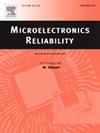Changes in the extraction and collection efficiency of GaN-based MQW solar cells under optical step-stress
IF 1.6
4区 工程技术
Q3 ENGINEERING, ELECTRICAL & ELECTRONIC
引用次数: 0
Abstract
InGaN/GaN multiple quantum well (MQWs) solar cells are promising devices for application in harsh environments. However, understanding their degradation kinetics can be complicated by the high periodicity of the active region (AR). To overcome this issue, we carried out an experiment on structures with only two quantum wells, having different indium concentrations, that were submitted to an optical power step stress at 55 °C. Firstly, illuminated current-voltage (I-V) characterizations indicate that the QW near the p-side of the device strongly contributes to carrier collection. This is explained by the enhanced hole extraction and collection efficiency. Notably, a non-monotonic ‘hump effect’ emerges when the device design is suboptimal. Secondly, during optical power step stress, two key phenomena were observed: a) a reduction in short-circuit current (Isc), especially at high excitation intensities; b) an increase in current conduction below the main diode turn-on voltage, which is ascribed to the increased amount of traps in the active region of the devices. The degradation leads to a reduction in the extraction and collection efficiency of photogenerated carriers, as evidenced by the decrease in the open circuit voltage (Voc), the parameter most affected by degradation. Results give insight for the optimization of InGaN/GaN-based solar cells structure, which can be used to improve performance and reliability.
求助全文
约1分钟内获得全文
求助全文
来源期刊

Microelectronics Reliability
工程技术-工程:电子与电气
CiteScore
3.30
自引率
12.50%
发文量
342
审稿时长
68 days
期刊介绍:
Microelectronics Reliability, is dedicated to disseminating the latest research results and related information on the reliability of microelectronic devices, circuits and systems, from materials, process and manufacturing, to design, testing and operation. The coverage of the journal includes the following topics: measurement, understanding and analysis; evaluation and prediction; modelling and simulation; methodologies and mitigation. Papers which combine reliability with other important areas of microelectronics engineering, such as design, fabrication, integration, testing, and field operation will also be welcome, and practical papers reporting case studies in the field and specific application domains are particularly encouraged.
Most accepted papers will be published as Research Papers, describing significant advances and completed work. Papers reviewing important developing topics of general interest may be accepted for publication as Review Papers. Urgent communications of a more preliminary nature and short reports on completed practical work of current interest may be considered for publication as Research Notes. All contributions are subject to peer review by leading experts in the field.
 求助内容:
求助内容: 应助结果提醒方式:
应助结果提醒方式:


